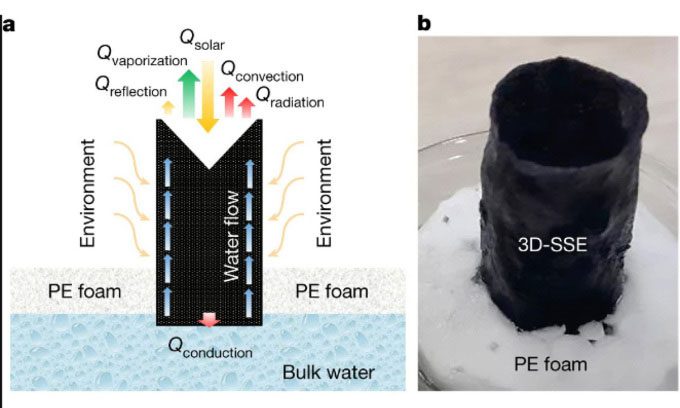Chinese Scientists Develop Efficient Method for Desalination Using Solar Evaporation.
A new method described as “green” and effective can filter more water daily compared to similar methods, SCMP reported on September 28. Specifically, the research team filters about 22 liters of water per square meter each day, sufficient for 10 adults. The study was recently published in the journal Nature.

The cylindrical evaporation device helps reduce energy loss and prevent salt blockage. (Photo: Nature).
The research team utilized a new type of titanium powder with high solar energy absorption capabilities, mixed with other materials to create cylindrical evaporation devices. These devices are designed to minimize energy loss compared to flat devices, achieving an evaporation rate of 6.09 kg per hour. Associate Professor Yang Bo from Northeast University and a member of the research team stated that their method has set a world record for evaporation speed.
Traditional desalination methods use reverse osmosis to separate salt from seawater. Specifically, water is passed through small membranes under pressure, causing the water to separate from other components. This process consumes a significant amount of energy. According to the U.S. Department of Energy, approximately 25-40% of the cost of desalinated water is allocated to the energy needed to operate the pumps and create osmotic pressure.
In the solar steam method, the evaporation device absorbs heat, turning water into steam and leaving salt behind. The steam moves to a cooler collection area, condensing into pure water.
Yang noted that this steam method does not produce carbon emissions as it relies on sunlight rather than pressure for desalination. His research provides a new approach to seawater desalination, effectively addressing water scarcity while saving energy through smart design.
With its large surface area, the cylindrical evaporation device can avoid salt blockage, which is essential for enhancing the efficiency of solar steam systems. The research team added that this method is not only a more sustainable way to desalinate seawater but could also be expanded to fuel production, steam sterilization, and electricity generation.



















































